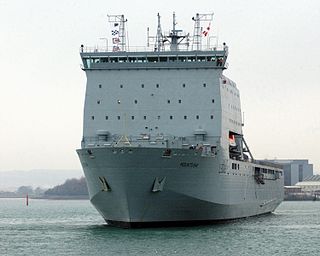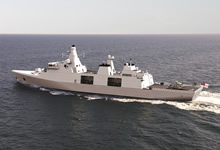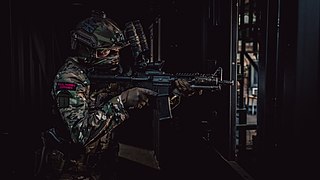Related Research Articles

The Royal Fleet Auxiliary (RFA) is a naval auxiliary fleet owned by the UK's Ministry of Defence. It is a component of His Majesty's Naval Service and provides logistical and operational support to the Royal Navy and Royal Marines. The RFA ensures the Royal Navy is supplied and supported by providing fuel and stores through replenishment at sea, transporting Royal Marines and British Army personnel, providing medical care and transporting equipment and essentials around the world. In addition the RFA acts independently providing humanitarian aid, counter piracy and counter narcotic patrols together with assisting the Royal Navy in preventing conflict and securing international trade. They are a uniformed civilian branch of the Royal Navy staffed by British merchant sailors. The RFA is one of five RN fighting arms.

HMS Albion is a landing platform dock of the Royal Navy, the first of the two-ship Albion class. Built by BAE Systems Marine in Barrow-in-Furness, Albion was launched in March 2001 by the Princess Royal. Her sister ship, Bulwark, was launched in November 2001, also from Barrow. Affiliated to the city of Chester and based in Plymouth, she is the ninth ship to carry the name Albion, stretching back to the 74-gun 1763 warship, and last carried by an aircraft carrier decommissioned in 1973 after 19 years service. Designed as an amphibious warfare ship, Albion carries troops, normally Royal Marines, and vehicles up to the size of the Challenger 2 main battle tank. She can deploy these forces using four Landing Craft Utility (LCUs) and four Landing Craft Vehicle and Personnel (LCVPs). A flight deck supports helicopter operations.

RFA Argus is a ship of the Royal Fleet Auxiliary operated by the Ministry of Defence under the Blue Ensign. Italian-built, Argus was formerly the container ship MVContender Bezant. The ship was requisitioned in 1982 for service in the Falklands War and purchased outright in 1984 for a four-year conversion to an Aviation Training Ship, replacing RFA Engadine. In 1991, during the Gulf War, she was fitted with an extensive and fully functional hospital to assume the additional role of Primary Casualty Receiving Ship. In 2009, the PCRS role became the ship's primary function. Argus is due to remain in service beyond 2030. In July 2022 it was reported that the future Littoral Strike Role would be assumed by Argus after a refit to convert her to this role. As of October 2023, Argus had started her deployment to serve as part of Littoral Response Group (South).

The Albion-class landing platform dock is a class of amphibious warfare ship in service with the Royal Navy. The class consists of two vessels, HMS Albion and HMS Bulwark, ordered in 1996 to replace the ageing Fearless class. Both ships were built by BAE Systems Marine at the former Vickers Shipbuilding and Engineering yard in Barrow-in-Furness. Albion was commissioned in 2003 and Bulwark in 2005. Each of the ships has a crew of 325 and can accommodate up to 405 troops. Thirty-one large trucks and thirty-six smaller vehicles and main battle tanks can be carried inside the vehicle deck. To disembark troops and vehicles, the vessels are equipped with eight landing craft. As of 2024, both vessels were in reserve. In November 2024, the newly elected Labour government indicated that the ships would be removed from service by March 2025.

HMS Bulwark is the second ship of the Royal Navy's Albion-class assault ships. She is one of the United Kingdom's two landing platform docks designed to put Royal Marines ashore by air and by sea though is due to be retired by March 2025.

RFA Lyme Bay is a Bay-class auxiliary dock landing ship of the British Royal Fleet Auxiliary (RFA). Ordered from Swan Hunter in 2000, the ship was launched in 2005. However, cost overruns and delays saw the shipbuilder removed from the project, and the incomplete ship was towed to Govan for finishing by BAE Systems Naval Ships. Lyme Bay entered service in late 2007; the last ship of the class to join the RFA.

RFA Cardigan Bay is a Bay-class landing ship dock of the Royal Fleet Auxiliary (RFA). Built by BAE Systems, the ship was dedicated into the RFA at the end of 2006.

The Bay class is a ship class of four dock landing ships built for the British Royal Fleet Auxiliary (RFA) during the 2000s. They are based on the Dutch-Spanish Royal Schelde Enforcer design, and replaced the Round Table-class logistics ships. Two ships each were ordered from Swan Hunter and BAE Systems Naval Ships. Construction work started in 2002, but saw major delays and cost overruns, particularly at Swan Hunter's shipyard. In mid-2006, Swan Hunter was stripped of work, and the incomplete second ship was towed to BAE's shipyard for completion. All four ships, Largs Bay, Lyme Bay, Mounts Bay, and Cardigan Bay had entered service by 2007.

Future planning of the Royal Navy's capabilities is set through periodic Defence Reviews carried out by the British Government.
A joint support ship (JSS) is a multi-role naval vessel capable of launching and supporting joint amphibious and airlift operations. It can also provide command and control, sealift and seabasing, underway replenishment, disaster relief and logistics capabilities for combined land and sea operations.

The Enforcer is a ship design created by Royal Schelde following the design and building of HNLMS Rotterdam. HNLMS Rotterdam was jointly developed by the Royal Netherlands Navy and the Spanish Navy.

The Type 31 frigate, also known as the Inspiration class, and formerly known as the Type 31e frigate or General Purpose Frigate (GPF), is a class of five frigates being built for the United Kingdom's Royal Navy, with variants also being built for the Indonesian and Polish navies. The Type 31 is intended to enter service in the 2020s alongside the eight submarine-hunting Type 26 frigate and will replace the five general-purpose Type 23 frigates. The Type 31 is part of the British government's "National Shipbuilding Strategy".
A Littoral Response Group (LRG) is a Royal Navy task group usually consisting of one or two amphibious warfare ships, a company of Royal Marines and supporting elements primarily tasked with littoral warfare from the littoral areas. They were first deployed in 2020 and have been described by the Royal Navy as being more flexible and agile compared to previous amphibious task groups with an emphasis on forward-basing, precision strike capabilities, high mobility, modern command and control technology, networked autonomous systems and deception capabilities. Multiple LRGs were to be able to combine to form a more substantial Littoral Strike Group (LSG) and also join a UK Carrier Strike Group to form an Expeditionary Strike Force.
Multi-Role Support Ship (MRSS) is a class of amphibious ship planned for the Royal Malaysian Navy (RMN).
The Type 32 frigate is a frigate currently in development in the United Kingdom for the Royal Navy. It was officially announced in November 2020 by Prime Minister Boris Johnson as a result of the Integrated Review. Built after the Type 26 and Type 31 frigates, the ship will be general-purpose and modular in its design and, after entering service in the 2030s, is expected to help grow the Royal Navy's surface escort fleet from 19 to 24 vessels.

The Future Commando Force (FCF) is an in-progress modernisation programme and transformation of the role and operations of the Royal Marines. The FCF essentially retasks 40 Commando and 45 Commando with forming two Littoral Response Groups (LRGs) which will be permanently deployed, though other units from UK Commando Force are also included in the composition of LRGs, as well as changing the role and operations of the Royal Marines and the equipment and tactics they use.

RFA Proteus is a ship of the Royal Fleet Auxiliary within His Majesty's Naval Service of the United Kingdom. Its roles being a platform for Remotely Operated Underwater Vehicles (ROUVs) and a testbed for new specialist capabilities, required for monitoring waters important to UK interests. Acquired in 2023, the ship entered drydock at Cammell Laird for modification into a Multi-Role Ocean Surveillance Ship (MROSS). She formally entered service in October 2023.

The Amphibious Transport Ship (ATS) is an initiative by the Dutch Navy to procure a series of six amphibious warfare ships as a replacement for the Rotterdam class and Holland class.
References
- 1 2 "Royal Marines to get six new ships which can launch drones and fire laser weapons". The Daily Telegraph . 14 May 2024. Retrieved 14 May 2024.
- ↑ "UK confirms it will build six new warships for Royal Marines". Reuters . 14 May 2024. Retrieved 14 May 2024.
- ↑ Vock, Ido (20 November 2024). "UK to decommission ships, drones and helicopters to save £500m". BBC.
- ↑ "Amphibious ships - Development of Royal Navy amphibious vessels". Parliament. Retrieved 14 May 2024.
- ↑ "Freedom of Information Request 2016/08608" (PDF). Ministry of Defence. Retrieved 14 May 2024.
- ↑ Vock, Ido (20 November 2024). "UK to decommission ships, drones and helicopters to save £500m". BBC.
- ↑ "Understanding the Royal Navy's littoral response group concept". Navy Lookout. 17 August 2021. Retrieved 14 May 2024.
- ↑ "The oldest ship in the Royal Naval Service to become the new Littoral Strike Ship". Navy Lookout. 20 July 2022. Retrieved 18 May 2024.
- ↑ Defence in a Competitive Age (PDF). Ministry of Defence. March 2021. ISBN 978-1-5286-2462-6. Archived (PDF) from the original on 2021-03-22. Retrieved 22 March 2021.
- ↑ Martin, Tim (30 November 2022). "UK drops funding of future Type 32 Frigate and Multirole Support Ships, for now". Breaking Defense. Retrieved 14 May 2024.
- 1 2 "Multi Role Support Ships – the future of Royal Navy amphibious capability | Navy Lookout". www.navylookout.com. 2023-09-04. Retrieved 2024-06-28.
- ↑ Scott, Richard (12 March 2024). "Netherlands outlines national route for new amphibious transport ship class" . Retrieved 14 May 2024.
- ↑ Karremann, Jaime (9 April 2024). "Amfibische Transportschepen krijgen mogelijk doorlopend dek". Marine Schepen (in Dutch). Retrieved 14 May 2024.
- ↑ "Royal Navy's Multi Role Support Ship programme to go ahead | Navy Lookout". www.navylookout.com. 2024-05-14. Retrieved 2024-06-28.
- ↑ Scott, Richard (2024-06-27). "UK sets its course for MRSS programme". Naval News. Retrieved 2024-06-28.
- ↑ "New Golden Age of shipbuilding as new UK-built warships boost Navy building programme to up to 28 ships and submarines". GOV.UK. 14 May 2024. Retrieved 14 May 2024.
- ↑ Martin, Tim (14 May 2024). "UK Royal Marines to acquire 6 new multirole support ships, cost yet to be decided". Breaking Defense.
- 1 2 Webb, Freddie (14 May 2024). "Royal Navy: MoD confirms 6 new Royal Marines support ships will be built amid Russia-Ukraine war". Portsmouth News. Retrieved 14 May 2024.
- ↑ "Six new amphibious warships to be built for Royal Marines operations". Royal Navy. 14 May 2024. Retrieved 14 May 2024.
- ↑ Allison, George (15 May 2024). "Future Royal Navy ships to need less crew". UK Defence Journal . Retrieved 16 May 2024.
- ↑ Kemp, Damian (14 May 2024). "New UK support ships to go ahead, LPDs to remain in service". www.shephardmedia.com. Retrieved 2024-06-03.
- 1 2 BMT (2019). "ELLIDA-200 Multi-Role Logistics Ship" (PDF). Retrieved 29 June 2024.
- 1 2 "In focus: the BMT ELLIDA multi-role and logistics vessel concept | Navy Lookout". www.navylookout.com. 2019-11-05. Retrieved 2024-06-29.
- ↑ Staff, Naval News (2023-09-15). "BMT unveils expanded Ellida Fleet-Design Offerings, Redefining Naval Support Operations for the Future". Naval News. Retrieved 2024-06-29.
- ↑ "BMT unveils expanded ELLIDA™ fleet-design". www.bmt.org. Retrieved 2024-06-29.
- ↑ "BMT develop second generation ELLIDA multi-role and logistic vessel concept | Navy Lookout". www.navylookout.com. 2023-10-30. Retrieved 2024-06-29.
- 1 2 "Steller Systems unveil 'Fearless' Multi Role Support Ship concept". www.navylookout.com. 2024-05-21. Retrieved 2024-06-03.
- 1 2 3 Vavasseur, Xavier (22 May 2024). "Fearless MRSS by Steller Systems". Youtube. Retrieved 3 June 2024.
- ↑ Staff, Naval News (2024-05-21). "Fearless MRSS: Enabling Littoral A2AD Pushback, Raiding and Landing Operations". Naval News. Retrieved 2024-07-21.